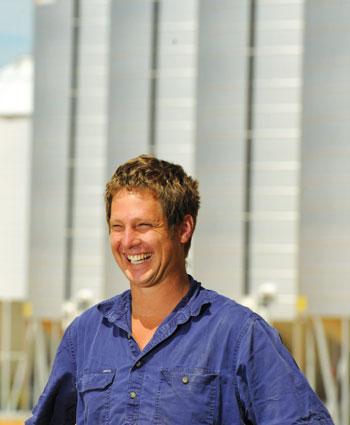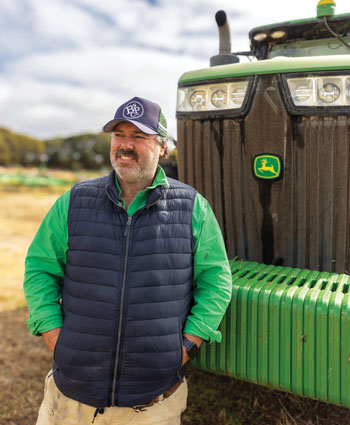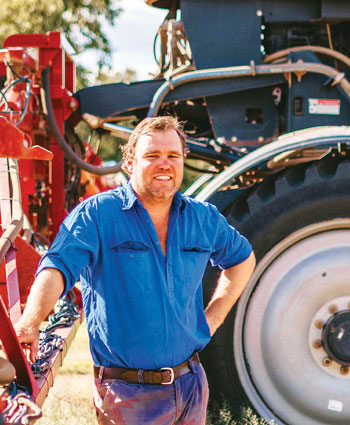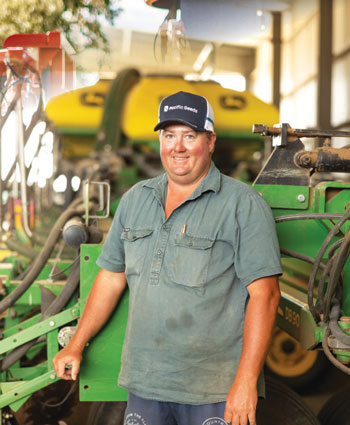Western Australia
Mitch and Emma Miolini farm with his brother Adam, sister-in-law India and their parents Robert and Maxine. The Miolinis are fourth-generation farmers at Mt Walker, 40 kilometres east of Narembeen in WA’s central wheatbelt. Their enterprise is a mixed farm, cropping wheat, canola, oats, barley and lupins and running 1500 head of breeding ewes.
Sporadic rainfall has seen a messy start to our seeding. We have had about 35 millimetres since March with an early May event of 15 to 25mm and a late May event of five to 10mm. This added to the reservoir of soil moisture from the February storms. We started sowing Bannister and some Goldie oats on 24 April as oats are less of a financial risk than canola.
The return for oats is good at $430 a tonne. Oats are also very good at stabilising our newly ameliorated country with their fibrous and vigorous root systems. We then swapped between wheat and barley, then to lupins and, finally, canola. We had to make some changes to our program, given the moisture availability, and cut our canola program down from 750 to 250 hectares.
Our weed burden has been low as the soils have retained some warmth with above-average May temperatures not conducive for winter weed germination.
Current rotations with pastures and fallows among the crops also help with effective weed control. However, the Matricaria is proving to be an increasing problem, which we are learning to manage.
At the end of May, half our program of 4200ha crop had germinated and 200ha was seeded to pastures – a mix of oat, vetch and tillage radish. At this point, we are looking at an average to above-average season and will make a call on nitrogen application at the end of July.
With the status of WA sheep markets, and our lack of feed for them, we will reduce stock numbers.
Victoria
Mitch Henderson with parents Craig and Pauline, brother Ben, cousin John and their families grow wheat, barley, lentils and oaten hay in Berriwillock, Wilkur and Brim in Victoria’s Mallee. They also rear poultry, using their wheat straw as bedding and then spreading it back onto paddocks as manure in a closed-loop system.
 Victorian Mallee grower Mitch Henderson. Photo: Brad Collis
Victorian Mallee grower Mitch Henderson. Photo: Brad Collis
Dry conditions through May put us about two weeks behind our ideal sowing schedule but there’s not a lot wrong. We might see a yield penalty of 300 to 400k/ha on top-end yield, depending on the modelling you look at, but the year is young.
We finished up dry-sowing on 24 May and two weeks later received seven to 10mm, which got most of the crop up. An isolated storm in early May dropped a patchy 40mm in a couple of paddocks, which gave us some early germination, putting about 20 per cent of our program about two weeks ahead of the rest. But this has worked to our advantage because we can stagger the spraying program with a bigger window to target inputs at the right time.
So even though we didn’t get a typical break, I’m still pretty confident and there’s nothing to be too concerned about yet.
Our parallelogram seeder set up with a (12mm) knife-point press-wheel system has provided more accurate seed placement and more uniform crop emergence with nothing planted too shallow or deep. As well, the knife-point press wheels create a furrow over the top of the seed, so we get a water harvesting effect that amplifies the impact of any rainfall. After 8.5mm of rain in May, I had a dig and it was wet down to 30mm.
This year, nearly half our program (45 per cent) is hay and legumes (GIA Thunder and PBA Hallmark XT lentils). Cereals make up the rest with an even split between wheat (Scepter, Calibre and Tomahawk CL Plus) and barley (Maximus).
Chicken manure was spread in a couple of paddocks near the sheds but generally the cereals have had 70kg/ha of (compound fertiliser) Granulock Z, and the lentils 50kg/ha. We top-dressed with about 150kg/ha of urea.
Our spraying program has begun with a broadacre early weed knockdown and we’ve been rolling our lentil country, flattening the furrows along with any sticks and rocks to increase our harvestability.
South Australia
Lachie Seears farms with his wife Rebecca, children Hugh and Anneliese, and his parents, Peter and Helen, at Lucindale in south-eastern South Australia. Their 6000ha enterprise comprises cropping (wheat, canola and broad beans), 6500 breeding ewes and 1250 breeding cows and heifers (building towards 2000 breeders).
 South-eastern South Australia’s Lachie Seears. Photo: Adrian Gale
South-eastern South Australia’s Lachie Seears. Photo: Adrian Gale
A dry start to the season prompted us to delay seeding until 22 May. We began by planting our Aquadulce broad beans dry.
We plant seeds we have retained and grown for the past 30 years, which suit our conditions well.
We sell them for export to Egypt, Morocco and South-East Asia for human consumption. Buyers pay more for larger beans. We sow our broad bean seed with a tyned air seeder set on 222.25mm (8.75 inch) row spacings.
On 30 May, 11mm of rain fell, bringing us to about 60mm by 31 May. In comparison, we had received 250mm of rain by 31 May last year. Our May herbicide bill was our lowest on record because of the dry start. The 11mm that fell on 30 May is insufficient to germinate the pasture, weeds and sown seed.
We aimed to finish our wheat and canola sowing by the third week in June. Our sowing window extends from the start of May to mid-June. Our finish is slightly later than I would like, but it will not be an issue if we have a kind spring.
Wheat is our other main crop. We prefer to grow hyper-yielding feed wheat, such as RGT Accroc, RGT Cesario and RGT Waugh (as a bulk-up), which is sold to domestic dairy farmers. We prefer sowing wheat and canola with a disc machine on 190.5mm (7.5-inch) row spacings.
Nick Poole’s work at Field Applied Research Australia, with GRDC investment, has been a game changer for high-rainfall growers. His efforts pointed us to high-yielding and disease-tolerant varieties, effective nitrogen management, the importance of two to three preventative fungicide sprays, and the use of plant growth regulators.
Due to decreased livestock prices, we have increased our cropping area this year. Accordingly, we have drilled Roundup Ready® canola into run-down pastures to clean up paddocks where grasses took over.
New South Wales
Andrew Freeth, his parents David and Sue and his brother Marc grow wheat, canola, chickpeas, faba beans, oats and 2200 ewes and trade cattle near Collie and Trangie in central New South Wales.
 Central New South Wales grower Andrew Freeth. Photo: Kirsty Fisher
Central New South Wales grower Andrew Freeth. Photo: Kirsty Fisher
We finished our sowing with chickpeas on 30 May, just before the rain arrived. We recorded about 20mm and did not need any more. From 1 January to 3 June, we have been fortunate to measure about 250mm of rain. The start of the season has been exceptional, and the crop establishment has been excellent.
My brother Marc and employee Jakob Ballantyne shared the sowing while I sprayed. Dad oversaw the operation and helped to move equipment.
We have prepared for a wetter-than-average season but know that anything can happen. Despite the strong price signal for planting chickpeas, we have maintained canola and faba beans in our rotation.
Milk thistle and annual ryegrass are two trickier weeds we targeted with a double knock.
Pyroxasulfone (Sakura®) was applied pre-sowing to paddocks sown with wheat, isoxaflutole (Balance®) and simazine to chickpeas. Terbuthylazine (Terbyne® Xtreme®) and simazine were applied to faba beans. Atrazine was applied to canola.
By 3 June, we had already spread 100 kilograms/ha of urea on our Illabo early grazing wheat. When anchored, our weaner cattle will graze it.
We will apply more urea to the Illabo wheat, our main-season wheat and canola before rainfall in June and July. Generally, we apply up to 160kg/ha but will go as high as 200kg/ha in wet seasons.
Further in-crop weed control will be done in the canola and grazing wheat when conditions dry.
We will monitor the faba beans and chickpeas for disease, deploying fungicide if needed.
We sold some wheat to fill contracts and the barley we had on hand because we were confident plenty of feed was available for our livestock.
Now our crops have emerged, we will start pricing some of them to take some risk off the table in line with our typical marketing plan.
Prices for all commodities have lifted across the board. A price of about $1000/t for new crop chickpeas is encouraging.
Queensland
Based at Capella, north of Emerald in Central Queensland, Tim Gersbach farms 4000ha with his wife Courtney, their two young children, and his parents Garry and Cathy. They crop wheat, chickpeas and, occasionally, mungbeans. Sorghum is the dominant summer crop.
With no decent rain since February, a lot of sorghum in the Central Queensland highlands has fallen over before harvest due to a good start and a dry finish.
We harvested our sorghum at 2.85t/ha and SOR1 grade. It was a pretty good result considering the season. If we’d had an extra 50mm in March or April it would have achieved at least 3t/ha.
We harvested sorghum at the same time as planting winter crops. We don’t normally have to do that. Most years we can finish planting the winter crop and go into the sorghum harvest, but seasonal conditions meant we had both at the same time this year.
We have planted 600ha of wheat and 1600ha of chickpeas. More chickpeas were planted because of the good prices on offer and because of the dry season. We can deep plant them to access moisture. There’s a full profile 100mm down, so we had to bust that up to plant down deep. We planted heavier this year too – based on what I’ve learnt from researchers at Emerald.
 Central Queensland grower Tim Gersbach. Photo: Rowdy Travis
Central Queensland grower Tim Gersbach. Photo: Rowdy Travis
We planted chickpeas at 75kg/ha compared with 60kg/ha and wheat at 60kg/ha, instead of 50kg/ha. Both had 30kg/ha of an NPKS fertiliser blend. Both the chickpeas and wheat are responding and have a pretty good strike on them, considering how deep they were planted.
Planting that deep was slow going. You can’t pull the tynes that fast when you are going that deep. We went at about 6.8 to 6.9km/hour compared with 9km/h. So you don’t get as much done in a day. We’ll need some rain on the wheat at least by early July. Chickpeas are on a full profile so they will do better for longer.
Weed-wise, we’ve put a residual down. If it rains, we will do an in-crop spray on the wheat. We have also been busy rolling our wheat paddocks. When the wheat is three to four weeks old, we roll the paddocks to push stones down. It’s better at harvest time.
We have some good equipment that we don’t want to be damaged by rocks. In the chickpea paddocks, we do the same thing, but start before the chickpeas come up.
The dry conditions have also had an impact on our earth-moving business. When it’s dry, the work increases. Those with livestock often want stock dams built. That business works well with a grain farm.
If it was wet now, we’d be busy spraying. But it’s not, so it’s good for the contracting business to be busy.

























































